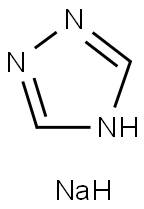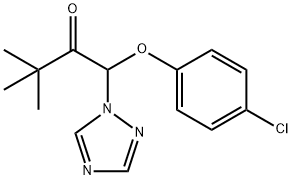Triadimenol , 96%, the heterogeneous mixture , 55219-65-3
Synonym(s):
α-tert-Butyl-β-(4-chlorophenoxy)-1H-1,2,4-triazole-1-ethanol
CAS NO.:55219-65-3
Empirical Formula: C14H18ClN3O2
Molecular Weight: 295.76
MDL number: MFCD00055507
EINECS: 259-537-6
| Pack Size | Price | Stock | Quantity |
| 5G | RMB239.20 | In Stock |
|
| 25G | RMB799.20 | In Stock |
|
| others | Enquire |
PRODUCT Properties
| Melting point: | 112-117° |
| Boiling point: | 465.4±55.0 °C(Predicted) |
| Density | 1.2990 (rough estimate) |
| vapor pressure | A 6 x l0-7 Pa (20 °C); B 4 x l0-7 Pa (20 °C) |
| refractive index | 1.5270 (estimate) |
| Flash point: | 2 °C |
| storage temp. | 2-8°C |
| solubility | DMSO (Slightly), Methanol (Slightly) |
| pka | 13.29±0.20(Predicted) |
| form | Solid |
| Water Solubility | A 62 mg l-1 (20 °C); B 33 mg l-1(20 °C) |
| color | White to Off-White |
| Merck | 13,9667 |
| BRN | 616470 |
| LogP | 2.900 |
| CAS DataBase Reference | 55219-65-3(CAS DataBase Reference) |
| NIST Chemistry Reference | Triadimenol(55219-65-3) |
| EPA Substance Registry System | Triadimenol (55219-65-3) |
Description and Uses
Triadimenol is a metabolite of triadimefon , a broad-spectrum chiral triazole fungicide, that is formed by reduction of a carbonyl group to the corresponding alcohol. It is teratogenic, inducing cranial nerve and ganglia abnormalities in a rat post-implantation whole embryo culture model when used at concentrations ranging from 12.5 to 125 μM. In vivo, triadimenol induces embryotoxicity in rats and rabbits when administered orally at doses of 100 and 40 mg/kg, respectively. Embryonic exposure to triadimenol (3-3,000 μg/L) induces embryonic mortality as well as decreases fertility and increases the number of female offspring in medaka fish (O. latipes).
Systemic agricultural fungicide; cereal seed protectant.
Safety
| Symbol(GHS) |    GHS07,GHS08,GHS09 |
| Signal word | Danger |
| Hazard statements | H302-H360D-H362-H411 |
| Precautionary statements | P202-P260-P263-P273-P301+P312-P308+P313 |
| Hazard Codes | Xn,F,T |
| Risk Statements | 22-52/53-36-20/21/22-11-23-20/22 |
| Safety Statements | 22-61-36-26-45 |
| RIDADR | 2588 |
| WGK Germany | 2 |
| RTECS | KK2200000 |
| HazardClass | 6.1(b) |
| PackingGroup | III |
| HS Code | 29339900 |
| Hazardous Substances Data | 55219-65-3(Hazardous Substances Data) |
| Toxicity | LD50 in male, female rats (mg/kg): 1161, 1105 orally; >5000 dermally, 24-hr; LD50 in quail: >10000 mg/kg (Frohberger) |





